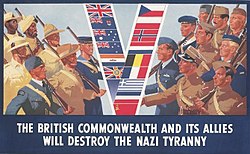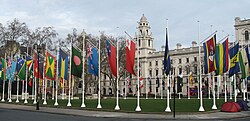Commonwealth of Nations
The Commonwealth of Nations (also known only as "Commonwealth") is a voluntary organisation of countries. Originally, it was called the British Commonwealth which was founded in 1926 when the British Empire began to break up. Now, there are 56 member countries of the Commonwealth.
Only countries which were part of the British Empire are allowed to become members of the Commonwealth (although an exception was made for Rwanda, Mozambique and Gabon which were never colonised by Britain, when they were allowed to become members). Members are free to leave and rejoin the Commonwealth. However, joining or rejoining the Commonwealth can become difficult, when the candidate country has serious human rights violations.
Origin
The term the Commonwealth of Nations originated in 1884. Lord Rosebery was on a visit to Australia in 1884. At Adelaide he said that over a period of time a number of colonies of the British Empire will become free and many may become more independent. He further said that all of these countries would then become the Commonwealth of Nations.
Purpose
The Commonwealth of Nations is not a political organization. King Charles III is also head of state of 16 Commonwealth countries, referred to as Commonwealth realms. Canada and Australia are two of the largest realms. A Secretary General manages the day-to-day matters of the Commonwealth of Nations. Patricia Scotland is the Secretary General since 2015. However, the United Kingdom or the Secretary General does not have any direct or indirect control over these countries. In fact, almost all the 53 members are independent countries with their own governments and hold Commonwealth Games. These countries have come together to form an association with some common aims. Such common aims include:
- To increase economic cooperation among the member countries.
- To encourage democracy in the member countries.
- To ensure that member countries follow human rights.
Some information
- The total population of all the 56 countries of the Commonwealth is about 2.245 billion. This is almost a third of the population of the whole world.[1] About half of these live in India.[2]
- The four largest Commonwealth nations by population are India at 1.37 billion, Pakistan at 230 million, Nigeria at 174 million, and Bangladesh at 166 million.
- Tuvalu and Nauru are the smallest members, each with less than 11,000 people.
- These 53 countries cover an area of 31,000,000 square kilometres (12,100,000 sq mi). This is about 21 % of the total land area of the world.
- The three largest Commonwealth nations by area are Canada at 9,800,000 square kilometres (3,800,000 sq mi), Australia at 7,800,000 square kilometres (3,000,000 sq mi), and India at 3,400,000 square kilometres (1,300,000 sq mi).
- The economy of these countries is about 16 % of the world economy.
- Based on the purchasing power parity, the four largest economies are India at 2,600 billion US dollars, the United Kingdom at 1,500 billion US dollars, Canada at 930 billion US dollars, and Australia at 520 billion US dollars.
Commonwealth Of Nations Media
Draft of the 1921 Anglo-Irish Treaty, with "British Empire" crossed out and "British Commonwealth of Nations" added by hand
The prime ministers of five members at the 1944 Commonwealth Prime Ministers' Conference: (L-R) Mackenzie King (Canada), Jan Smuts (South Africa), Winston Churchill (United Kingdom), Peter Fraser (New Zealand) and John Curtin (Australia)
Poster from the Second World War, depicting soldiers from Britain, Canada, Australia, New Zealand, the Colony of Southern Rhodesia, South Africa and imperial India
Queen Elizabeth II, the longest-serving Head of the Commonwealth, was in office for 70 years.
Marlborough House, London, the headquarters of the Commonwealth Secretariat, the Commonwealth's principal intergovernmental institution
The high commission of The Gambia in New Delhi
The Judicial Committee of the Privy Council is the highest court of appeal for several Commonwealth nations.
Soldiers of the Indian Army 5th Gurkha Rifles in post-war Japan as part of the British Commonwealth Occupation Force, 1946
Flags of the Commonwealth countries in Parliament Square, London on Commonwealth Day
References
- ↑ "US and World Population Clock". US Census Bureau. 29 June 2013. Retrieved 30 June 2013.
- ↑ "Country Comparisons – Population". The World Factbook. Central Intelligence Agency. 19 March 2009. Archived from the original on 27 September 2011. Retrieved 22 March 2009.
Other websites
| Wikimedia Commons has media related to Lua error in Module:Commons_link at line 62: attempt to index field 'wikibase' (a nil value).. |
- Commonwealth of Nations -Citizendium











